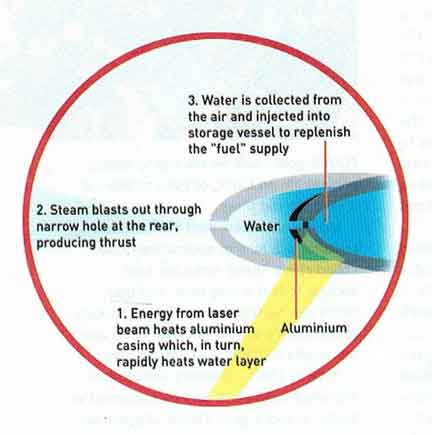|
"Zecharia Sitchin makes a surprising connection," the magazine Atlantis Rising announced on its November/December 2002 cover, introducing Zecharia's article "The Ancients and the Power of Water":
"Will water be the fuel of the future to power aircraft and spacecraft?" Zecharia's article asked, and gave the startling answer, "If so, mankind will be employing a 'technology of the gods' and, as in other fields, modern science will be only catching up with ancient knowledge". The full text of the article follows:
WATER: THE ULTIMATE PROPELLANT By Zecharia Sitchin Will water be the fuel of the future to power aircraft and spacecraft? If so, mankind will be employing a "technology of the gods" and, as in other fields, modern science will be only catching up with ancient knowledge. The news of the possible use of water - an abundant and clean resource - as the "fuel" for jet propulsion comes from the Tokyo Institute of Technology that has been developing technologies for powering small un-piloted planes by subjecting their "engines" to laser beams fired from the ground or from satellites. In what has been hailed as a great success, the Tokyo team reported in the June 10 issue of Applied Physics that they made a tiny paper "plane" fly by subjecting its "motor" of aluminum plates to laser beams. Causing minute amounts of the metal to vaporize, a jet stream was achieved that cause the plane to soar. The experiment thus attained the trick of creating an ejected jet of some mass that pushed the plane forward. In regular jet planes, the jet is created by burning petroleum fuel and ejecting the hot gas. In the Tokyo experiment, the heat was provided by the laser beam, the jet by the evaporated aluminum. To scale the propulsion system up to full size, Takashi Yabe, head of the Tokyo team, proposed using water as the propellant. "Water can be harvested from the atmosphere as the plane flies," he said. Reporting the experiment and the water-use idea, the journal New Scientist (15 June 2002) illustrated the futuristic "water engine" thus:
"Water An Intriguing Fuel" Reporting the series of
experiments, The New York Times science editor Kenneth Chang stated
that "water is the more intriguing fuel. The paper airplane received only a single push before the
water propellant was used up, but Dr. Yabe speculated that a larger plane
using this technology could continually replenish the water from the air,
"so we don't need to carry large amounts of water," he said. A Technology of the Anunnaki I admit to having broadly grinned when I read the above news reports, because in my latest book, The Lost Book of Enki, I described the use of water for the propulsion of the spacecraft of the Anunnaki ("Those who from heaven to Earth came" in Sumerian). Enki, the great chief scientist of the Anunnaki, was the leader of the first team of Anunnaki to come to Earth. His name, EN.KI, meant "Lord of Earth" in Sumerian. But that title was granted to him only later, after the arrival of his half-brother Enlil (EN.LIL = "Lord of the Command"). The original Epithet-name of Enki was E.A., commonly taken to mean "He whose home is water." He was depicted by the Sumerians as a seated deity outpouring streams of water (see PIC). He was the prototype of the Water Bearer Aquarius and his zodiacal constellation (see PIC).
At first I accepted the explanation that his epithet reflected his love of waters, for sailing and fishing. As the scope of my research and writings expanded, increasingly involving the "technologies of the gods," I was increasingly astounded to discover that modern science is only catching up with ancient knowledge. This was true in astronomy, then in genetics, and now in space propulsion.
The Sumerian incredible knowledge of the heavens applied not only to recognition of all the planets we know of today (plus Nibiru), but also to their descriptions and roles. Thus, Mars was spoken of as The Way Station. NASA's own photographs from the 1970's, shown in my book Genesis Revisited, reveal the remains of artificial structures on Mars. But the argument has been that Mars could not have served as an astronauts' base because it is a lifeless, atmosphere-less and a dry, waterless planet. Well, all of a sudden we hear from the same space experts that oh, yes, Mars not only had rivers and lakes and oceans in the past - it still has vast quantities of water frozen at its poles and lying inches below the surface elsewhere… So Mars could not only sustain a Way Station: It could serve to re-supply the spacecraft of the Anunnaki with their fuel: Water. Did the engine devised by Enki have to evaporate the water to create a jet? Probably not: The water itself could be ejected - an idea as simple as the lawn sprinkler… © Z. Sitchin 2002 (Reprints permitted provided the copyright
|


